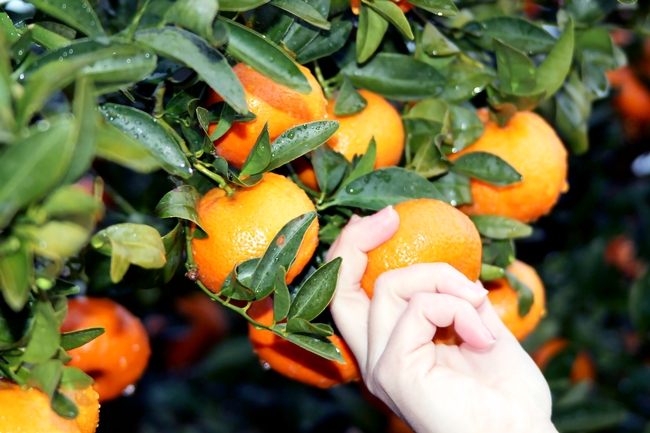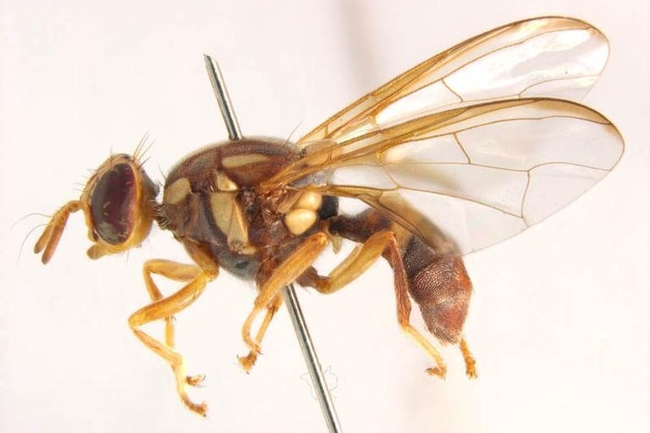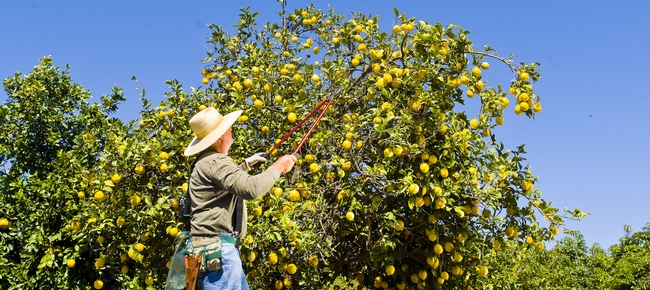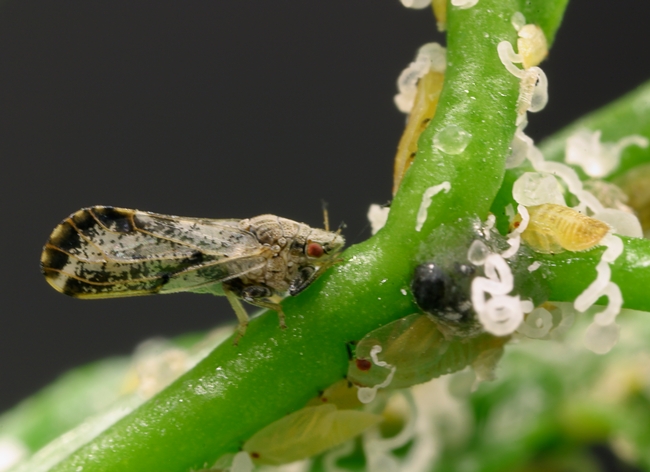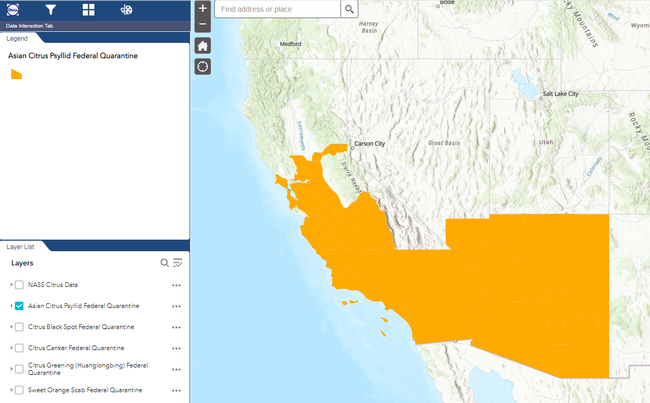Posts Tagged: CDFA
Hands-on learning, training make irrigation best practices accessible
UCCE advisors provide free training to nursery and greenhouse staff
Working as an irrigator seems straightforward at first: if you're not watering plants by hand, you're building and managing systems that can do the watering. What could be complex about a job like this?
University of California Cooperative Extension advisors Bruno Pitton and Gerardo “Gerry” Spinelli can tell you – or better yet, show you.
Pitton and Spinelli, members of the UC Nursery and Floriculture Alliance, offer a one-day technical training in irrigation best-management practices for irrigators working with containerized nursery plants. The comprehensive curriculum – developed with input from two focus groups of California nursery and greenhouse managers – aims to improve irrigation efficiency, reduce water consumption and improve plant health.
Thanks to funding from the California Department of Food and Agriculture, nursery and greenhouse managers in California can request this training for free and advisors like Pitton and Spinelli will travel to conduct the training on-site.
The complexities of irrigation incorporate concepts like evapotranspiration, salinity, irrigation uniformity, capillarity, pressure and flow rate. Spinelli, UCCE production horticulture advisor for San Diego County, said that irrigators have a critical role in the industry because of all the things they must consider to do their job well.
“Our goal is to support irrigators and help them become more confident decision-makers and experts in the field,” said Pitton, UCCE environmental horticulture advisor for Placer and Nevada counties.
Interactive sessions reveal nuances of irrigation
The training consists of a presentation on fundamental concepts for managing irrigation in container plant production and hands-on demonstrations. “In the nursery industry, where precise irrigation is crucial for the health and productivity of our crops, having access to expert knowledge is invaluable,” said Mauricio de Almeida, general manager of Burchell Nursery in Fresno County. “The training's practical demonstrations and real-world examples made the concepts easy to grasp, allowing our team to implement the strategies immediately.”
For one of the demonstrations, the advisors used sponges to model soil saturation when water is applied. Ana, an irrigator at Burchell Nursery, appreciated the step-by-step explanations, which helped her better understand how water pressure differs in drip irrigation, sprinklers and watering by hand. Doing this out in the field, as an example of how irrigation audits occur, was extremely helpful for attendees.
Francisco “Frank” Anguiano, production manager of Boething Treeland Farms in Ventura County, observed his team of irrigators as they learned how to measure distribution uniformity with water collected from sprinklers. “This training isn't just about irrigation and plant management. It's also about savings, both water and costs. Who doesn't want to save money and use less water?” Anguiano said.
Reducing the barriers to learning
Many of the irrigators attending these trainings gained their skills and knowledge from life experience rather than a college education, explained Peter van Horenbeeck, vice president of Boething Treeland Farms. “It's important that my irrigators learn from external experts, but it's more important that they can relate to them. And that's what Gerry was able to do,” van Horenbeeck added.
Regarding content and delivery, and referencing what he learned from the focus groups, Pitton wanted the trainings to be easy to understand and engaging. For example, scientists use the term “matric potential” to describe how soil particles hold water against gravity, which is the same as capillary rise. “We demonstrate this concept with a paper towel held vertically and dipped into a beaker of dyed water that it absorbs,” said Pitton.
Many of the irrigators in attendance agreed that hands-on activities and visual aids were instrumental to their learning. Charli, another irrigator at Burchell Nursery, shared that the in-field examples and hosting the training in Spanish kept them engaged.To address language barriers, Spinelli has been conducting trainings in Spanish – a common request from many nurseries with eager participants.
Maintaining state regulations and partnerships
Although the technical aspects of irrigation management are key elements of the training, regulatory compliance is also addressed. Recognizing the finite availability of water and the environmental impact of pollution, the advisors highlight irrigation and fertilizer management and runoff prevention as critical components of compliance.
Under Ag Order 4.0 administered by California's Water Resources Control Board, growers must comply with stricter policies regulating nitrogen use. As irrigators learn from the training, better control of irrigation can certainly make a difference.
Deanna van Klaveren, chief operating officer and co-owner of Generation Growers in Stanislaus County, said the most valuable aspect of the training was learning on-site and completing an audit on her own systems. “It is so much more impactful to have trainings like this on-site where our staff can learn and then go out into the nursery and actually put it into practice while the presenters/experts are there,” van Klaveren said.
Pitton and Spinelli described the partnership between UC Cooperative Extension and CDFA as “symbiotic” given the technical and educational capacity of UCCE advisors who conduct research and extension.
“It's a great example of how the two institutions can collaborate successfully. Californians are the ones who win because they get a service for free,” added Spinelli. “And it's rewarding for us to see so much interest in what we, as advisors, do.”
If you are a nursery or greenhouse operator and would like to request the Irrigation Best Management Practices training, please contact the UCCE advisor assigned to the region that corresponds with your nursery location below.
Northern California
- Jessie Godfrey, UCCE environmental horticulture and water resources management advisor, jmgodfrey@ucanr.edu
Central Coast (Santa Cruz County to Ventura County)
- Emma Volk, UCCE production horticulture advisor, evolk@ucanr.edu
San Joaquin Valley
- Chris Shogren, UCCE environmental horticulture advisor, cjshogren@ucanr.edu
Southern California
- Grant Johnson, UCCE urban agriculture technology advisor, gejohnson@ucanr.edu
Spanish Trainings Only
- Gerry Spinelli, UCCE production horticulture advisor, gspinelli@ucanr.edu
Lawn-pocalypse! Surviving Drought
Ah, summer! The season of sunburns, pool parties, and… lawn droughts. If your once lush, green carpet now looks like a crunchy brown doormat, you're not alone. Let's dive into why your yard is staging a dramatic death scene and what you can do to...

Bermuda grass and weeds overtaking drought stressed turf grass.
Carey Engages Audience in California's Fruit Fly Crisis
If you missed UC Davis distinguished professor James R. Carey's well-attended seminar on "California's Fruit Fly Invasion: A 70-Year Struggle Nears Critical Mass," it's now online on YouTube. His seminar, which took place June 3 in Briggs...
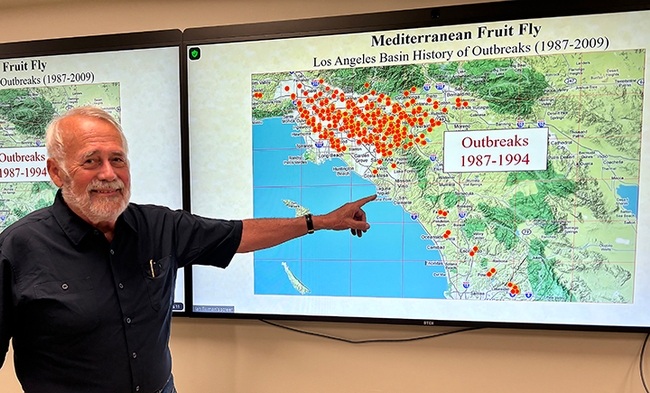
UC Davis distinguished professor James R. Carey presented a seminar on "California's Fruit Fly Invasion: A 70-Year Struggle Nears Critical Mass" on June 3 in Briggs Hall, UC Davis campus, and on Zoom. (Photo by UC Davis distinguished professor Walter Leal)
First-ever Queensland fruit fly quarantine restricts moving homegrown produce
QFF quarantine in LA, Ventura counties among seven fruit fly quarantines statewide
Residents in multiple Southern California and Northern California counties should not move homegrown fruits and vegetables from their properties to help contain several species of fruit fly that can destroy crops and impact the livelihoods of local farmers.
With sharing and gifting of food integral to the holiday season, the California Department of Food and Agriculture is reminding people to heed the seven active fruit fly quarantines aimed at controlling the Mediterranean fruit fly, Oriental fruit fly, Tau fly and Queensland fruit fly. The links below describe quarantine zone boundaries:
- Mediterranean fruit fly: Los Angeles County, Leimert Park Area
- Oriental fruit fly: San Bernardino and Riverside Counties, Redlands and Yucaipa Areas
- Oriental fruit fly: Sacramento County, Rancho Cordova Area
- Oriental fruit fly: Contra Costa County, Brentwood Area
- Oriental fruit fly: Santa Clara County, Santa Clara Area
- Tau fly: Los Angeles County – Stevenson Ranch, Valencia, Santa Clarita Areas
- Queensland fruit fly: Ventura and Los Angeles Counties, Thousand Oaks Area
People within these zones should consume or process (i.e., juice, freeze or cook) their homegrown fruits and vegetables at the place of origin and not move them off their property. Uneaten produce should be double-bagged in plastic bags and disposed of in the landfill bin – not compost or green waste.
Queensland fruit fly threatens California citrus, other crops
The Queensland fruit fly (Bactrocera tryoni) quarantine is the first of its kind in the U.S. Although QFF was first seen in California in 1985, the recent detection of two adult males triggered the unprecedented quarantine action by USDA's Animal and Plant Health Inspection Service and CDFA.
“This pest has earned a bad reputation for wreaking havoc on fruit production in Australia, where it is native,” said Hamutahl Cohen, University of California Cooperative Extension entomology advisor for Ventura County. “Adult flies lay their eggs in fruit, and the eggs hatch into larvae that then feed on the fruit, causing damage.”
And while females of other fruit fly species live for only two or three months, QFF females are unique in that they can live up to a year, according to Cohen.
“Once QFF populations take root, they're challenging to manage because females can each lay up to 100 eggs per day,” Cohen said.
In addition to being highly adaptable to a variety of environmental conditions, QFF has more than 170 host plants – including a wide range of California commodities such as citrus, grape, strawberry, fig, avocado, apricot, peach, cherry, nectarine, plum, pear, apple, tomato and sweet pepper.
The threat to citrus is especially concerning, as Southern California growers continue to grapple with the specter of spreading huanglongbing (HLB) disease, which kills citrus trees. Cohen said residents of citrus-growing regions can do their part to help their neighbors and local economy by respecting quarantine restrictions.
“Growers are already dealing with other invasive species like Asian citrus psyllid [vector of HLB pathogen], so we as homeowners need to prevent the spread of fruit flies to reduce the burden on them,” she explained.
While a spike this year in the detections of multiple fruit fly species was likely caused by a host of factors, Cohen speculates that increased post-pandemic travel is helping to move the flies. And with holiday travel in full swing, she said it's important to practice “Don't Pack a Pest” principles.
“Invasive species often hitchhike on fruits and vegetables brought into California by travelers – that's why we often first find invasive species in urban and suburban backyards, and not on farms,” Cohen said. “Travelers entering the U.S. can visit dontpackapest.com to learn about which products they can and cannot bring back with them.”
To report a suspected infestation of fruit fly larvae in homegrown produce, call the CDFA pest hotline at 1-800-491-1899. Growers with questions and concerns are urged to contact their local agricultural commissioner's office.
Citrus Care in the Sharing Season - Help Prevent the Spread of Asian Citrus Psyllid (ACP)
As gardeners, we're often generous with our garden's bounty. From sharing seeds and plant trimmings to the joy of gifting homegrown fruit and vegetables, gardening is as much about community as it is about growing plants. However, in this season of sharing, we must also remember our responsibility to prevent the spread of pests and invasive species to protect California's diverse ecosystem.
First detected in California in 2008, Asian citrus psyllid (ACP) has been a concern for both commercial citrus growers and home gardeners. ACP poses a significant threat to California's citrus trees, capable of spreading the deadly huanglongbing (HLB) disease, an incurable condition that eventually kills the tree.
Detecting ACP involves looking for a few key characteristics. ACP is a tiny, mottled brown insect about the size of an aphid. Adults are typically 3 to 4 millimeters long and are identified by their distinctive body shape, where the head is narrower than the body, and they hold their wings tent-like over their bodies. They are most active during warm temperatures, and you might notice them jumping or flying when disturbed. The nymphs, the immature form of the psyllid, are yellowish-orange and secrete white, waxy tubules from the back of their abdomen.
Additionally, ACP leaves telltale signs on citrus leaves, such as twisted or curled new leaf growth. They are sap-feeders, like aphids and mealybugs, so they produce honeydew which leads to the growth of sooty mold. Regularly inspecting your citrus trees, especially the new growth, is key to early detection of ACP.
Recent updates to the USDA's Plant Protection and Quarantine citrus map highlights areas that are generally infested with ACP and those which are not. This distinction is crucial for understanding the regulations and eradication efforts in different regions across the state. To find detailed quarantine information by county or zones, visit the California Department of Food and Agriculture (CDFA) ACP Regulation and Quarantine Boundaries website and maps.
Looking at the map pictured above, areas in the southern region of California, south of the Grapevine or San Gabriel and Tehachapi Mountain Ranges, and as far up the coast as Santa Barbara County are considered generally infested. The CDFA does not carry out eradication efforts for ACP in these areas. In areas north of the Grapevine, an ACP detection on a residential citrus tree would trigger an eradication response from the CDFA.
As we approach the holiday season, a popular time for gardeners to share budwood for grafting, it's crucial to understand the importance of not moving citrus planting material between quarantine areas. It is especially important not to move budwood or citrus from Southern California or the Bay Area into California's Central Valley.
To aid in this effort, UC Master Gardener Program resources are available to help educate you about identifying ACP and understanding the quarantine regulations. Here are some key actions you can take:
- Only purchase new citrus trees from reputable nurseries.
- Do not accept tree cuttings or budwood from friends or family.
- After pruning or removing a citrus tree, dry out the green waste or double bag it to help ensure the green waste is disposed of appropriately.
- Control ants in and near citrus trees with bait stations. Scientists have released natural enemies of ACP in Southern California to help keep the pest in check, but ants aid ACP in evading the natural enemies.
The UC Agriculture and Natural Resources ACP website offers an interactive map tool, biological control efforts, and an online calculator for the potential costs of using insecticides. Additionally, the Statewide UC Integrated Pest Management website provides free online training for gardeners and detailed Pest Notes on ACP and HLB disease. Remember, inspecting your citrus trees is vital to prevent the spread of ACP and HLB. If you suspect an infestation, contact the CDFA Exotic Pest Hotline at 1 (800) 491-1899 or your local county agricultural commissioner.
Let's continue to share the bounties of our gardens, but let's do so responsibly, keeping our citrus trees safe and healthy. Together, we can make a difference in the fight against ACP and HLB.







